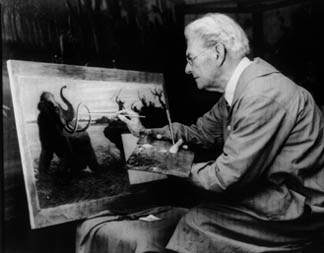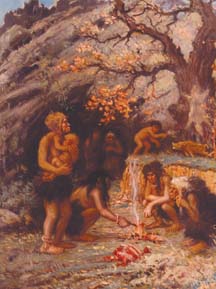'Conquering Darkness' -- Knight's dinosaur art at Museum of the Earth
By Dan Aloi
The artist who gave the world its first glimpse of prehistoric life in 3-D and living color is the subject of a new special exhibition at the Museum of the Earth.
"Conquering Darkness: The Art of Charles R. Knight," on display now through April 30, features more than 30 paintings and 10 sculptures by Knight (1874-1953). More than any other single artist of the 20th century, Knight influenced (and still influences) the popular image of the prehistoric world.

The works in the exhibition include an early self-portrait and sketches of Knight's family, a series of lifelike dinosaur models, paintings of dinosaurs, prehistoric mammals, sharks and early humans and an unfinished painting of a jaguar from 1953.
"He put the image of prehistoric animals into the consciousness of everyday life, by working with paleontologists," said Bridget Rigas-Gangi, director of development and public relations at the museum, located on Route 96 just north of Ithaca.
Legally blind by age 6, Knight was an accomplished artist specializing in natural history before he began working with paleontologist Edward Drinker Cope at the Academy of Natural Sciences in Philadelphia. He interpreted Cope's findings from fossil specimens and created rich, animate landscapes and animal studies that were the most accurate of their time. His combination of art and science influenced generations of writers, artists and filmmakers including Ray Harryhausen ("King Kong") and Steven Spielberg ("Jurassic Park").

The works on display are from the collections of the Academy of Natural Sciences and of the late artist's granddaughter, Rhoda Knight Kalt.
This is the only current exhibit on the East Coast of Knight's paintings and sculptures together, and the first such exhibit anywhere in more than two decades. After reading a New York Times article in May about the Paleontological Research Institution (PRI) and its affiliation with Cornell, Kalt contacted Warren Allmon, PRI director and adjunct professor of earth and atmospheric sciences. (The PRI building adjacent to the museum houses Cornell's non-botanical fossil collection; museum holdings also include a Knight sculpture of an Apatosaurus from 1905, among several models used to show how what we know about dinosaurs has changed over time.)
"She chose us," Rigas-Gangi said of Kalt. "She wanted this exhibit to be here." Kalt recently announced that Knight's artwork is for sale during the run of the Ithaca exhibit, and Kalt will donate 5 percent of each sale to the museum.
Media Contact
Get Cornell news delivered right to your inbox.
Subscribe